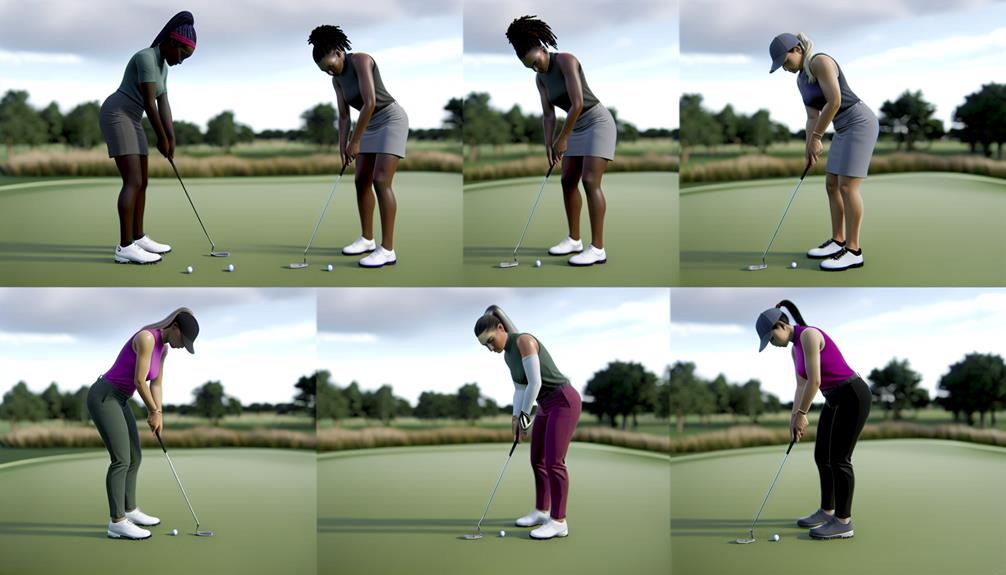When it comes to the green, everyone has their fair share of 'educational moments'. You've experienced them – those times when the ball veers off course, or stops just shy of the hole.
But let's not dwell on past frustrations. Instead, let's focus on solutions. Imagine if those 'moments' could be minimized, or even eliminated?
What if there were strategies, proven by the pros, that could perfect your putting? As we explore these eight key strategies adopted by professional golfers, you'll find that the secret to your ideal putt might be simpler than you think, and yet, there's a world of nuances waiting to be uncovered.
Mastering the Pendulum Stroke
To truly master the pendulum stroke in golf, you must understand its mechanics down to a tee, focusing on maintaining a consistent tempo and a straight-line movement with your putter. This technique demands a blend of stance adjustment and eye coordination.
Your stance is the foundation of the swing. It's not just about bending your knees or keeping your feet shoulder-width apart. Rather, it's a complex balance between flexibility and stability. Tweaking your posture can significantly influence the trajectory and control of your shot.
Eye coordination is another vital component. You've got to train your eyes to follow the ball from the beginning of your backswing to the moment of impact and beyond. It's about synchronizing your eyes with the movement of your putter. Improving your eye coordination isn't an overnight feat, it requires practice and patience.
Importance of Green Reading
While perfecting your pendulum stroke is crucial, it's just as important to pay close attention to the subtleties of the green, understanding its breaks and slopes for a successful putt. This process, known as green reading, is a combination of art and science that can drastically reduce your score if mastered properly.
Green analysis and slope interpretation are two fundamental components of green reading. You've got to scrutinize the green from multiple angles, looking for changes in colour and texture that may indicate variations in grass type, grain direction, moisture levels, or underlying soil conditions. These factors can influence the speed and direction of your putt.
Slope interpretation is about understanding how the ball will behave on the green's surface. Will it roll straight or deviate to one side? Will it speed up or slow down as it moves across the green? To answer these questions, you'll need to assess the green's overall slope, the gradient and direction of any local slopes, and the green's firmness.
Perfecting the Putting Grip
Mastering your putting grip, a key factor in consistent successful strokes, directly affects your control over the ball's speed and direction. A well-executed grip ensures that your stroke is smooth and steady, thereby maximizing accuracy.
The first aspect to perfect is grip strength. Too tight and you'll likely jerk the ball off its intended path; too loose and you risk losing control. Ideally, your grip should be firm enough to maintain control, but relaxed enough to allow for a fluid stroke. You should feel some pressure in the last three fingers of your leading hand, but your forearms shouldn't feel tense.
Next, let's consider wrist positioning. Keeping your wrists firm and steady during your putt is critical. Any unnecessary wrist movement can introduce instability into your stroke, causing the ball to deviate from its intended path. The back of your leading hand should continue to point towards your target throughout your stroke, ensuring your putter face remains square to the ball.
Key to Consistent Stroke Speed
Achieving a consistent stroke speed, the heartbeat of any successful putt, is crucial in golf and it's something you can perfect with dedicated practice and the right strategy. The key lies in mastering two elements: stroke rhythm and speed control.
Stroke rhythm is the tempo of your putting stroke, the time it takes for your clubhead to travel from the start of your backswing to the end of your follow-through. Maintaining a steady rhythm helps combat sudden jerks or hesitations that can disrupt your stroke's fluidity. Try counting a steady 'one-and-two' beat in your head as you swing.
Speed control, on the other hand, is all about managing the power behind your stroke. Too much speed and the ball will overshoot the hole; too little, and it won't reach. Regular practice on different terrains and slopes will help you develop a feel for the right amount of speed to apply in varying situations.
The Art of Pressure Putting
Once you've gotten a handle on your stroke speed, it's time to tackle another crucial aspect of pro golfing – the art of pressure putting. This is where your mental fortitude truly comes into play.
Pressure putting isn't just about physical ability; it's about staying calm and focused under intense scrutiny. It's about stepping up to the ball, knowing the stakes are high, and delivering a perfect putt. To excel in pressure situations, you need to build your confidence.
Confidence building starts with practice. The more you practice, the more you trust in your ability to make the shot, no matter the circumstances. It's about repetition and consistency. It's about learning to trust your swing, your judgment, and your decision-making under stress.
Another technique is visualization. Imagine yourself making the perfect putt under pressure, over and over again. This mental exercise can dramatically boost your confidence and your performance.
Lastly, embrace the pressure. Remind yourself that pressure is a privilege – a sign that you've reached a level where your performance matters. Use it to fuel your drive and determination.

